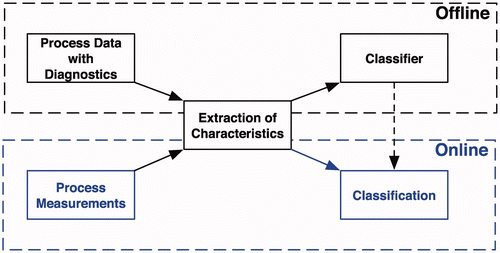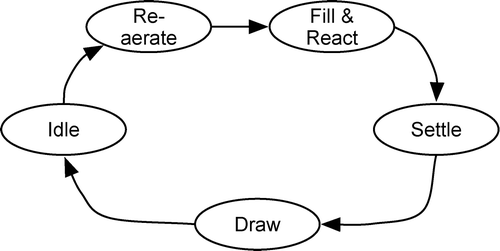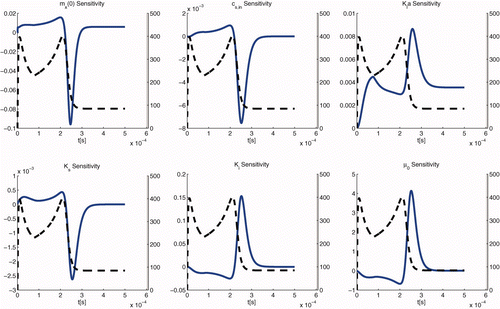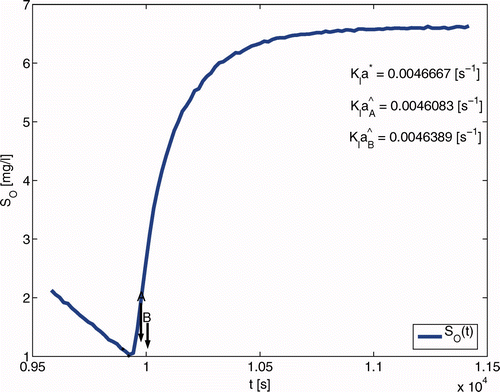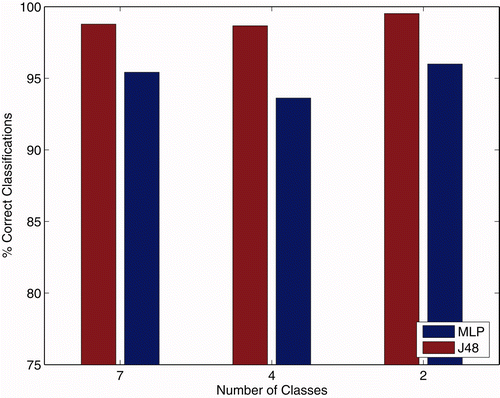Abstract
Process fault diagnosis (PFD) allows a control system to maintain the operation of a process under the presence of faults. This is a critical feature for a discontinuous activated sludge waste water treatment (WWT) process in a sequencing batch reactor (SBR), treating waste water contaminated with organic toxic compounds. Here, a methodology for diagnosis based on the extraction of characteristics from the respiration signal, a known indicator for biological activity in aerobic WWT processes, and their classification is proposed. The usefulness of the signal for the detection and classification of a set of defined abnormal conditions was verified through sensitivity analysis. The analysis not only shows the effects of parameter deviations but also indicates the characteristics to be extracted from the respiration signal for a successful classification. Results obtained by simulation indicate that the signal based PFD can successfully cope with uncertainties common in this type of bioprocesses, which prevent the straightforward application of analytical PFD approaches.
1. Introduction
Sequencing batch reactors (SBR) for waste water treatment (WWT) based on the fill-and-draw principle Citation1 are commonly employed to deal with variations in flow and composition of residual waters Citation2. For autonomous operation, these batch processes require a control system that maintains the operation even under the presence of faults. To achieve this goal, the process has to be permanently monitored to detect the presence of faults, diagnose their type and size Citation3, and take corresponding actions. Different authors Citation4-8 have presented a large variety of methods for process fault diagnosis (PFD) with examples from different areas. Nonetheless, given the uncertainties of the quantitative models used to describe WWT processes, recent publications Citation9-12 indicate a tendency towards application of methods from the area of artificial intelligence (AI) and statistics for the detection and isolation of process faults. Many of these data based PFD methods make use of feature extraction and classification, where the diagnosis is obtained from a classification model that is created from knowledge extracted from historical process data and diagnostic information. The difference between the various methods is marked by the difference in type and obtainment of characteristics, classification models and algorithms. Generally, the procedures involve two parts. The first one is carried out offline and aims at producing a classification model, that can either be constructed by experts, based on statistics, or obtained using machine learning techniques. The second part is the online application of the classifier for the detection of the process behaviour and possible faults. A visualization of this methodology is presented in . The main requirement of data based PFD is that data is available and accompanied by diagnostic information. While in many cases historical data from operations is the main source, it is also possible to generate data and diagnostic information using an uncertain mathematical model. An example of this case is presented in this paper, that is concerned with data based PFD of an aerobic SBR WWT process treating 4-chlorophenol (4-CP, an inhibitory organic toxic compound) contaminated waste water. Given the absence of sufficient historical data, a process model that has been selected and identified from laboratory experiments and reported in the EOLI project Citation13 is introduced and transformed so that a continuous online estimate of the respiration rate during the SBR reaction phase with feeding can be obtained. This process signal has been widely recognized as an indicator for biological activity and employed for monitoring and control purposes Citation14.
The usefulness of the respiration signal for the detection of a set of defined abnormal conditions (e.g. process faults) is verified through sensitivity analysis Citation15. Results from this analysis not only show the effects of parameter deviations but also indicate the characteristics that should be extracted from the respiration signal for a successful classification. Consequently, a feature extraction and classification procedure is proposed, which is designed to diagnose the formerly defined process faults. The paper concludes with results for diagnosis under conditions affected by uncertainties that are very common in bioprocesses and usually do prevent the straightforward application of well studied analytical PFD approaches.
2 Model
2.1 Process model
The studied process consists of five phases in the sequence that is given below and visualized in :
-
Idle: The reactor is not in use.
-
Re-aerate: The biomass in the reactor is re-aerated to saturation, to ensure that oxygen is available when the substrate enters the reactor.
-
Fill and React: The working volume of the reactor is filled with residual water (influent) and microorganisms in suspension (activated sludge) within the reactor degrade organic and nitrogen compounds through metabolic activity.
-
Settle: The activated sludge sediments to the bottom of the tank.
-
Draw: The working volume of treated water is removed from the reactor (effluent).
The process is operated with fixed time intervals as described in Citation16.
2.2 Reaction phase model
The EOLI project provided a validated model named EM1 Citation17, which is based on concentrations and describes the dynamics of a 4-CP contaminated water treatment process through the following set of equations:
The specific growth rate for the modelled single aerobic growth reaction is represented by the following Andrews model Citation18
2.3 Respiration rate
In the case of aerobic WWT processes, the oxygen consumption rate of the biomass, called respiration rate in the following, has been widely recognized as an indicator for biological activity and employed for monitoring and control purposes Citation14. This has been verified in the studied case, where process dynamics obtained through changes in some parameters and initial conditions, are directly reflected in the respiration signal of the reaction phase, as presented in .
Figure 3. Respiration profiles (nominal dashed, a with c s,in − 30% and m x (0) + 30%, b with c s,in − 30%, m x (0) + 30%, K s − 30% and K i + 50%, c with c s,in + 30%, m x (0) − 30%; all deviations from nominal values).
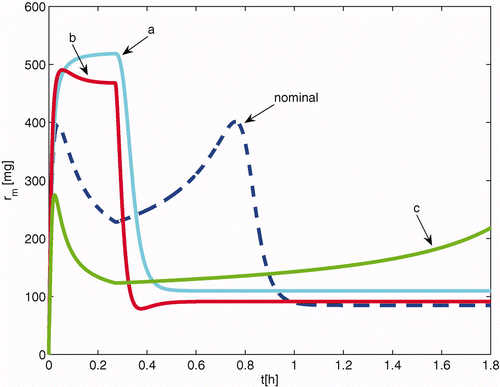
Although respirometric equipment is commercially available, it represents an additional cost and maintenance factor and does not provide a continuous online estimation of the in situ respiration. An alternative possibility is to use a software sensor based on the oxygen balance and a dissolved oxygen concentration measurement to estimate the respiration rate r
m
by software. The oxygen mass balance that is part of the process model (
EquationEquation 3), actually includes the term that accounts for the respiration rate defined by
EquationEquation (6)
.
For continuous WWT processes, this has been suggested before by Citation19 and Citation20. For batch processes, Citation21 describe a method for obtaining respiration rates from a batch reactor in situ, but non-continuous. All of these methods assume a constant volume, an assumption that does not hold for the SBR operation considered here, where a change in volume will occur concurrently with the reaction. A discrete time observer that estimates the mass respiration rate r
m
can be derived for
EquationEquations (5) and
Equation(6)
similar to the one described in Citation22:
3 Feasibility analysis of respiration rate based fault diagnosis
3.1 Sensitivity analysis of the respiration rate
The dynamics of the respiration rate are influenced by
the initial condition of the biomass m x (0), which may change due to population dynamics or purging; | |||||
the substrate concentration in the inflow c s,in , which may change due to waste water origin and productive process cycles; | |||||
the extrinsic growth behaviour of the biomass on inhibitory substrates, that is given in
EquationEquation (4) | |||||
K s is the half saturation coefficient; | |||||
K i is the inhibition coefficient; | |||||
μ0 is the specific growth rate; | |||||
The analysis was therefore concentrated on these parameters, and it is assumed that the parameters are constant during the reaction phase. As an example, the time dependent sensitivity function of the variable r m with respect to the initial condition m x (0) is
-
Deviations in c s,in and m x (0) affect the behaviour of r m similarly, but the effect is distinguishable from the ones caused by deviations in K s , K i and μ0.
-
The deviation of K l a affects r m during the complete phase and specifically in the minima, the second maxima and the end of the reaction phase.
-
The deviation of K s affects r m at the very beginning and at the second maximum.
-
The deviation of K i strongly affects the second maximum of the signal.
-
The effect of deviations in K s and K i at the second maximum of the signal are opposed.
-
Deviations in μ0 and K i affect the behaviour of r m similarly.
3.2 Definition of faults
The parameters m x (0) and c s,in are commonly known to be within a certain range represented by the interval obtained from nominal value ± Δ%, where Δ is governed by SBR operating conditions. These parameters are therefore considered to be uncertain but not as faults and based on the first observation they can be distinguished from deviations in K s , K i and μ0. On the other hand, deviations greater than nominal parameter value ± Δ% of the latter parameters are defined as abnormal conditions (faults) here. Considering the first observation, it was assumed that uncertainties in m x (0) and c s,in may occur concurrently, contrary to unpermitted deviations in K s , K i and μ0 which, considering the last two observations, may be difficult to detect if faults occur at the same time. Slow changes in these parameters between reaction phases will lead to a detection in subsequent process cycles. The effect of the deviation in the K l a on r m ( ) indicates that large uncertainties in the transfer parameter may have a negative effect on the diagnosticability.
3.3 Estimation of the transfer coefficient Kla
Assuming that (a) the parameter K
l
a changes only slowly when the air flow rate is constant Citation19 and (b) that respiration behaviour is invariable, the re-aeration phase (
) can be exploited for its online identification and use the obtained estimate in the subsequent batch cycle for the estimation of r
m
. Based on these assumptions, a discrete model can be obtained from
EquationEquation (5) using a zero-order-hold (ZOH) and reduced to
Using
EquationEquation (10), two identification algorithms for the parameter K
l
a have been implemented. Both can be applied if re-aeration starts from an initial condition value S
O
(0) << S
O,sat − r
e
and ends near steady state conditions (
, or S
O
≅ S
O,sat − r
e
).
-
A linear regression (least squares estimate), using all samples obtained during the re-aeration period, a standard offline parameter identification method as described in Citation24, Sec. 4.1.
-
A Kalman filter for parameter identification, an online parameter identification method as described in Citation24, p. 325.
The implementation of the online identification of the oxygen transfer parameter K
l
a over consecutive cycles allows to enhance the result using the estimated
as initial value θ(0) for the algorithm in the subsequent cycle.
4 Fault diagnosis
4.1 Selection of characteristics of the respiration rate
Based on the observations and the faults defined in Section 3.1, the following selection of characteristics is proposed to be extracted from the respiration signal
are as follows:
t max,1, the time until the first maximum r max,1 | |||||
r max,1, and r max,2 the two maxima | |||||
r min, the minimum between the two maxima | |||||
The geometric properties of the triangle a t , b t , c t , α t , β t and γ t , that are defined by the points r max,1, r max,2 and r min. | |||||
r e , the endogenous respiration estimate and | |||||
r tot , the total metabolic respiration defined by | |||||
For standardized results, the characteristics are obtained and calculated from a min–max normalization of the signal, by locating the minima and maxima specific for the studied case. Signals that are qualitatively different from the nominal pattern in can be detected at this point but not diagnosed. However, they have diagnostic interpretations known to the human expert: (i) in mean little or no inhibition and (ii) c means reaction unfinished.
4.2 Process data with diagnostic information
The basis for the FDI schema presented in
is historical process data with corresponding diagnostic information. However, in the investigated SBR process case, only few experiments were available, mainly due to the fact that these experiments are very time- and cost-intensive. Nonetheless, the analytical process model
EquationEquations (3) and
Equation(4)
provides the possibility of generating the required data. The expected uncertainties in parameters and initial conditions can be taken into account with simulations that use a random sampling approach.
4.3 Classification
The detection of an unpermitted deviation in one of the parameters K s , K i or μ0 will be represented by a set of two classes and for the isolation, two more sets of 4- and 7 classes providing additional information about the fault will be considered:
-
2-classes: {normal, abnormal} representing detection only;
-
4-classes: {K i , K s , μ0, normal} representing detection of unpermitted deviation and isolation of the parameter that changed; and
-
7-classes: {K i,low, K i,high, K s,low, K s,high, μ0,low, μ0,high, normal} representing detection of the unpermitted deviation, isolation of the parameter that changed and the direction of the change;
The classification models themselves can be categorized in two groups:
-
Black-box models: The acquired knowledge is implicit (e.g. ANN).
-
White-box models: The acquired knowledge is explicit (e.g. rules or decision trees).
5 Results
The method proposed for fault diagnosis based on the uncertain mathematical model has been verified with a set of simulations. These take into account uncertainties of ±25% in m x (0), the initial biomass and c s,in the substrate concentration in the inflow, as well as an error of 5–10% in the identification of the parameters K s , K i and μ0. The inflow rate q in as well as all other parameters have been assumed to be known and constant.
To obtain classification results for feature sets that have not been used for training, the complete generated data set has been randomly permuted and split into training (2/3) and test (1/3) sets. The first has been used as input for the machine learning algorithms that yield the classification models for the detection (2-classes) and diagnostic cases (4-,7-classes). The latter has been used to obtain the classification results for unknown feature sets that have not been used for training. A 10-fold cross validation ensures that the results are representative for an online use of the generated classification models. A comparison of the average of the classification results of the 10 folds of the two types of classifiers and the three sets of diagnostic classes is presented in .
6 Conclusions
A signal-based PFD procedure is presented, that is based on the selection of characteristics and classification algorithms with an uncertain mathematical model. The employed model describes the corresponding aerobic SBR process that treats waste water contaminated with 4-chlorophenol, an inhibitory organic toxic compound. In a first step, the original concentration based model is transformed to a mass balance model that allows to estimate the respiration rate during the fill and reaction phase of the process.
Changes in the behaviour of the respiration rate signal due to variations in parameters are evaluated through the application of sensitivity analysis. The results from the analysis (i) confirm that the respiration rate is indeed a good indicator for biological activity that can be used for PFD; (ii) show that it is possible to discern between nominal and faulty behaviour in spite of specific uncertainties, if the oxygen transfer parameter K l a is estimated periodically; and (iii) indicate the signal characteristics that should be extracted from the signal for a successful classification for PFD.
Consequently, an estimation method for the transfer parameter K l a and an extraction procedure for the signal characteristics is presented. The latter are employed to construct classification models through well-known machine learning algorithms for pattern recognition.
Results show that despite the above mentioned uncertainties proposed, the PFD procedure is quite successful, given that the percentage of correct diagnosis is above 95% in almost all cases. This indicates that the machine learned classification models can be used online for the detection and diagnosis of certain process faults, which cannot be detected by a straightforward application of analytical PFD approaches.
Acknowledgements
This paper includes the results of the EOLI project that is supported by the INCO program of the European Community (contract number ICA4-CT-2002-10012).
References
- US EPA . 1999 . Wastewater technology fact sheet – Sequencing batch reactors, EPA 832-F-99-073
- Mace , S. and Mata-Alvarez , J. 2002 . Utilization of SBR technology for wastewater treatment: An overview . Ind. Eng. Chem. Res. , 41 : 5539 – 5553 .
- Isermann , R. and Ballé , P. 1997 . Trends in the application of model-based fault detection and diagnosis of technical processes . Control Eng. Practice , 5 : 709 – 719 .
- Venkatasubramanian , V. 2003 . A review of process fault detection and diagnosis: Part I: Quantitative model-based methods . Comput. Chem. Eng. , 27 : 293 – 311 .
- Venkatasubramanian , V. 2003 . A review of process fault detection and diagnosis: Part II: Qualitative models and search strategies . Comput. Chem. Eng. , 27 : 313 – 326 .
- Venkatasubramanian , V. 2003 . A review of process fault detection and diagnosis: Part III: Process history based methods . Comput. Chem. Eng. , 27 : 327 – 346 .
- Blanke , M. 2003 . Diagnosis and fault-tolerant control , Berlin Heidelberg : Springer .
- R. J. Patton P. M. Frank R. N. Clark Issues of Fault Diagnosis for Dynamic Systems Springer Verlag London 2000
- Montserrat , R. 2004 . Qualitative trends for situation assessment in SBR wastewater treatment process . BESAI 4th ECAI Workshop on Binding Environmental Sciences and Artifical Intelligence . 2004 , Valencia, Spain.
- Rodriguez-Roda , I. 2002 . A hybrid supervisory system to support wwtp operation: implementation and validation . Water Science and Technology , 45 : 289 – 297 .
- Baeza , J. A. , Ferreira , E. C. and Lafuente , J. 2000 . Knowledge-based supervision and control of wastewater treatment plant: a real-time implementation . Water Science and Technology , 41 : 129 – 137 .
- Sanguesa , R. and Burrell , P. 2000 . Application of bayesian network learning methods to waste water treatment plants . Applied Intelligence , 13 : 19 – 40 .
- Betancur , M. , Dochain , D. and Fibrianto , H. 2004 . EOLI Workpackage 2: Model selection and parameter identification, Technical Report Deliverable D2.3: Validated Model, European Community Research
- H. Spanjers P. A. Vanrolleghem G. Olsson P. L. Dold Respirometry in Control of the Activated Sludge Process Principles, Technical Report No.7, International Water Association 1998
- Frank , P. M. 1978 . Introduction to System Sensitivity Theory , New York : Academic Press .
- Betancur , M. J. Modeling for the optimal biodegradation of toxic wastewater in a discontinuous reactor . Microbial Population Dynamics in Biological Wastewater Treatment (ASPD4) . Queensland, Australia.
- Betancur , M. J. , Dochain , D. and Fibrianto , H. 2004 . Validated model. EOLI Deliverable 2.3, ICA4-CT-2002-10012 , European Community Research .
- Andrews , J. F. 1968 . A mathematical model for the continous culture of microorganisms utilizing inhibiting substrates . Biotechnol. Bioeng. , 10 : 707 – 723 .
- Lindberg , C.-F. and Carlson , B. 1996 . Estimation of the respiration rate and oxygen transfer function utilizing a slow do sensor . Wat. Sci. Tech. , 33 : 325 – 333 .
- Marsili-Libelli , S. and Vaggi , A. 1997 . Estimation of respirometric activities in bioprocesses . Journal of Biotechnology , 52 : 181 – 192 .
- Yoong , E. T. , Lant , P. A. and Greenfield , P. F. 2000 . In situ respirometry in an SBR treating waste water with high phenol concentrations . Wat. Res. , 34 : 239 – 245 .
- Wimberger , D. and Verde , C. 2005 . Online monitoring of an aerobic SBR process based on dissolved oxygen measurement . Proceedings of the IFAC World Congress (IFAC) . 2005 .
- Aström , K. J. and Wittenmark , B. 1984 . Computer Controlled Systems , UK : Prentice Hall .
- Söderström , T. and Stoica , P. 1989 . System Identification (Series in Systems and Control Engineering) , UK : Prentice Hall .
- Witten , I. H. and Frank , E. 2000 . Practical Machine Learning Tools and Techniques with Java Implementations , San Francisco, CA : Morgan Kaufmann .
